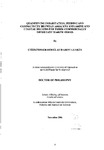QUANTIFYING INHABITATION, FEEDING AND CONNECTIVITY BETWEEN ADJACENT ESTUARINE AND COASTAL REGIONS FOR THREE COMMERCIALLY IMPORTANT MARINE FISHES
| dc.contributor.author | LEAKEY, CHRISTOPHER DOUGLAS BAZETT | |
| dc.contributor.other | Faculty of Science and Engineering | en_US |
| dc.date.accessioned | 2013-10-22T09:13:18Z | |
| dc.date.available | 2013-10-22T09:13:18Z | |
| dc.date.issued | 2006 | |
| dc.identifier | NOT AVAILABLE | en_US |
| dc.identifier.uri | http://hdl.handle.net/10026.1/2268 | |
| dc.description.abstract |
1. Estuaries are regarded as valuable nursery habitats for many commercially important marine fishes. Recruitment of fish from estuarine nursery habitats to adult marine populations is considered important for maintenance of fishable stocks, but most evidence for this is qualitative. Effective and timely implementation of estuarine conservation and fisheries management plans may be aided by quantitative assessment of this habitat connectivity. 2. This thesis reports upon the quantification of inhabitation, feeding and connectivity between adjacent estuarine and coastal regions for Common sole (Solea solea), European sea bass (Dicentrarchus labrax) and Whiting (Merlangius merlangus). Sample collection was focused in the Thames Estuary and adjacent coastal regions. 3. Two techniques were employed: (i) stable isotope analysis of soft tissues for tracing feeding signals; and (ii) elemental analysis of fish otoliths for tracing patterns of fish movement and residency. 4. Analysis of δ13C, δ15N and δ34S data identified significant differences in isotopic signatures between estuarine and coastal invertebrates, and allowed re-classification to sample sites with 98.8% accuracy. 5. Using invertebrate data as source indicators, stable isotope data classified juvenile fishes to the region in which they fed using stable isotope data. Feeding signals primarily reflected physiological (freshwater tolerance) and functional (mobility) differences between species. 6. Mixing models calculated estuarine contributions to adult muscle tissue isotopic composition. Juvenile bass have an affinity for estuarine feeding, followed by greater plasticity (individual level) in habitat choice as older fish, facilitated by their mobility and tolerance of low salinities. Sole show this plasticity (population level) in estuarine-coastal feeding as juveniles, and then lower plasticity with more consistently marine diets as adults. Whiting exhibited plasticity (individual level) as both juveniles and adults. 7. Chemical composition of juvenile fish otoliths reflected their region of collection (95- 100% accuracy). Misclassifications were indicative of between-habitat movement by whiting. Only juvenile sole showed significant energetic benefits of an estuarine existence. 8. Adult otolith chemistry data supported the stable isotope results. Variable plasticity in the use of estuarine and coastal resources was revealed, depending upon the species. 9. This research provides quantitative insight into resource use and estuarine-coastal habitat connectivity for these three species, as well as valuable guidance for similar future applications of soft-tissue stable isotope analysis and elemental analysis of fish otoliths. | en_US |
| dc.description.sponsorship | Centre for Environment, Fisheries and Aquaculture Sciences | en_US |
| dc.language.iso | en | en_US |
| dc.publisher | University of Plymouth | en_US |
| dc.title | QUANTIFYING INHABITATION, FEEDING AND CONNECTIVITY BETWEEN ADJACENT ESTUARINE AND COASTAL REGIONS FOR THREE COMMERCIALLY IMPORTANT MARINE FISHES | en_US |
| dc.type | Thesis | |
| dc.identifier.doi | http://dx.doi.org/10.24382/3487 |
Files in this item
This item appears in the following Collection(s)
-
01 Research Theses Main Collection
Research Theses Main


